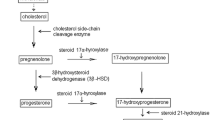Summary
The influence of exercise on blood borne substrates in relation to plasma catecholamine (CA) levels has been studied in untrained subjects (eight men and eight women). Subjects pedalled a bicycle ergometer for 20 min at a workload approximating to 80% maximal aerobic power. During exercise women reacted similarly to men except that their weight loss and hematocrit were significantly lower. At the end of the bicycling test, plasma dopamine (DA), norepinephrine (NE) and epinephrine (E) concentrations increased similarly in both groups. There was no significant difference in blood energy substrates between men and women except that the plasma free fatty acid (FFA) level was significantly higher in the female. When fitness levels were similar, the previously reported sex-related difference in response to exercise seemed to disappear. The lack of correlation between blood borne substrates variations and CA changes raised the question whether other hormonal factors combined with CA could play a role in the mobilization of energy substrates during exercise.
Similar content being viewed by others
References
Adams WC (1980) Blood volume in young men and women: relation to body composition and aerobic capacity. Med Sci Sport 12: 97
åstrand PO (1952) Experimental studies of physical working capacity in relation to age and sex. Munksgard, Copenhagen, pp 1–104
Banister EW, Griffiths J (1972) Blood levels of adrenergic amines during exercise. J Appl Physiol 33: 674–676
Bloom SR, Johnson RH, Park DM, Rennie MJ, Sulaiman WR (1976) Differences in the metabolic and hormonal response to exercise between racing cyclists and untrained individuals. J Physiol (Lond) 258: 1–18
Bransford DR, Howley ET (1979) Effects of training on plasma FFA during exercise in women. Eur J Appl Physiol 41: 151–158
Christensen EH, Hansen O (1939) Zur Methodik der Respiratorischen Quotient. Bestimmungen in Ruhe and bei Arbeit. Scand Arch Physiol 81: 137–151
Claustre J, Peyrin L, Fitoussi R, Mornex R (1980) Sex differences in the adrenergic response to hypoglycemic stress in human. Psychopharmacology (Berlin) 67: 147–153
Costill DL, Fink WJ, Getchell LH, Ivy JL, Witzmann FA (1979) Lipid metabolism in skeletal muscle of endurance-trained males and females. J Appl Physiol: Respirat Environ Exercise Physiol 47: 787–791
Cureton KJ, Sparling PB (1980) Distance running performance and metabolic responses to running in men and women with excess weight experimentally equated. Med Sci Sports 12: 288–294
Da Prada M, Zürcher G (1976) Simultaneous radioenzymatic determination of plasma and tissue adrenaline, noradrenaline and dopamine within fento-mole range. Life Sci 19: 1161–1174
Frankenhaeuser M, Dunne E, Lundberg U (1976) Sex differences in sympathetic adrenal medullary reactions induced by different stressors. Psychopharmacology (Berlin) 47: 1–5
Friedberg SJ, Sher PB, Bogdonoff MD, Harves Estes E, Jr (1963) The dynamics of plasma free fatty acid metabolism during exercise. J Lipid Res 4: 34–38
Galbo H, Christensen NJ, Holst JJ (1977) Glucose induced decrease in glucagon and epinephrine responses to exercise in man. J Appl Physiol: Respirat Environ Exercise Physiol 42: 525–530
Hermansen L (1973) Oxygen transport during exercise in human subjects. Acta Physiol Scand [Suppl] 399: 1–104
Hermansen L, Hultman E, Saltin B (1967) Muscle glycogen during prolonged severe exercise. Acta Physiol Scand 71: 129–139
Hunter WM, Fonseka CC, Passmore R (1965) Growth hormone; important role in muscular exercise in adults. Science (NY) 150: 1051–1052
Jurkowski JE, Jones NL, Walker WC, Younglai EV, Sutton JR (1978) Ovarian hormonal responses to exercise. J Appl Physiol: Respirat Environ Exercise Physiol 44: 109–114
Kalkhoff RK (1975) Effects of oral contraceptive agents on carbohydrate metabolism. J Steroid Biochem 6: 949–956
Kim HJ, Kalkhoff RK (1975) Sex steroid influence on triglyceride metabolism. J Clin Invest 56: 888–896
Maughan RJ, Williams C, Campbell DM, Hepburn D (1978) Fat and carbohydrate metabolism during low intensity exercise: effects of the availability of muscle glycogen. Eur J Appl Physiol 39: 7–16
Nielsen B (1969) Thermoregulation in rest and exercise. Acta Physiol Scand [Suppl] 323: 1–74
Pequignot JM, Peyrin L, Mayet MH, Flandrois R (1979) Metabolic adrenergic changes during submaximal exercise and the recovery period in man. J Appl Physiol: Respirat Environ Exercise Physiol 47: 701–705
Pequignot JM, Peyrin L, Peres G (1980) Catecholamine-fuel interrelationships during exercise in fasting men. J Appl Physiol: Respirat Environ Exercise Physiol 48: 109–113
Pruett EDR (1970) Plasma insulin concentrations during prolonged work at near maximal oxygen uptake. J Appl Physiol 29: 155–158
Sanchez J, Pequignot JM, Peyrin L, Monod H (1980) Sex differences in the sympatho-adrenal response to isometric exercise. Eur J Appl Physiol 45: 147–154
Senay LC Jr (1979) Temperature regulation and hypohydration: a singular view. J Appl Physiol 47: 1–7
Tzankoff SP, Norris AH (1979) Age-related differences in lactate distribution kinetics following maximal exercise. Eur J Appl Physiol 42: 35–40
Van Loon GR, Schwartz L, Sole MJ (1979) Plasma dopamine responses to standing and exercise in man. Life Sci 245: 2273–2278
Vendsalu A (1960) Studies on adrenaline and noreadrenaline in human plasma: VI — Plasma concentrations of adrenaline and noradrenaline during muscular work. Acta Physiol Scand [Suppl 173] 49: 57–69
Wahren J, Felig P, Ahlborg G, Jorfeldt L (1971) Glucose metabolism during leg exercise in man. J Clin Invest 50: 2715–2725
Wallace JP, Hamill CL, Druckenmiller M, Hodgson JL, Mendez J, Buskirk ER (1980) Concentrations of metabolic substrates during prolonged exercise in men and women. Med Sci Sports 12: 101
Author information
Authors and Affiliations
Additional information
E.R. 196 CNRS Métabolisme des catécholamines
E.R.A. 330 CNRS Adaptations respiratoire et circulatoire á l'exercice musculaire
Rights and permissions
About this article
Cite this article
Favier, R., Pequignot, J.M., Desplanches, D. et al. Catecholamines and metabolic responses to submaximal exercise in untrained men and women. Europ. J. Appl. Physiol. 50, 393–404 (1983). https://doi.org/10.1007/BF00423245
Accepted:
Issue Date:
DOI: https://doi.org/10.1007/BF00423245




